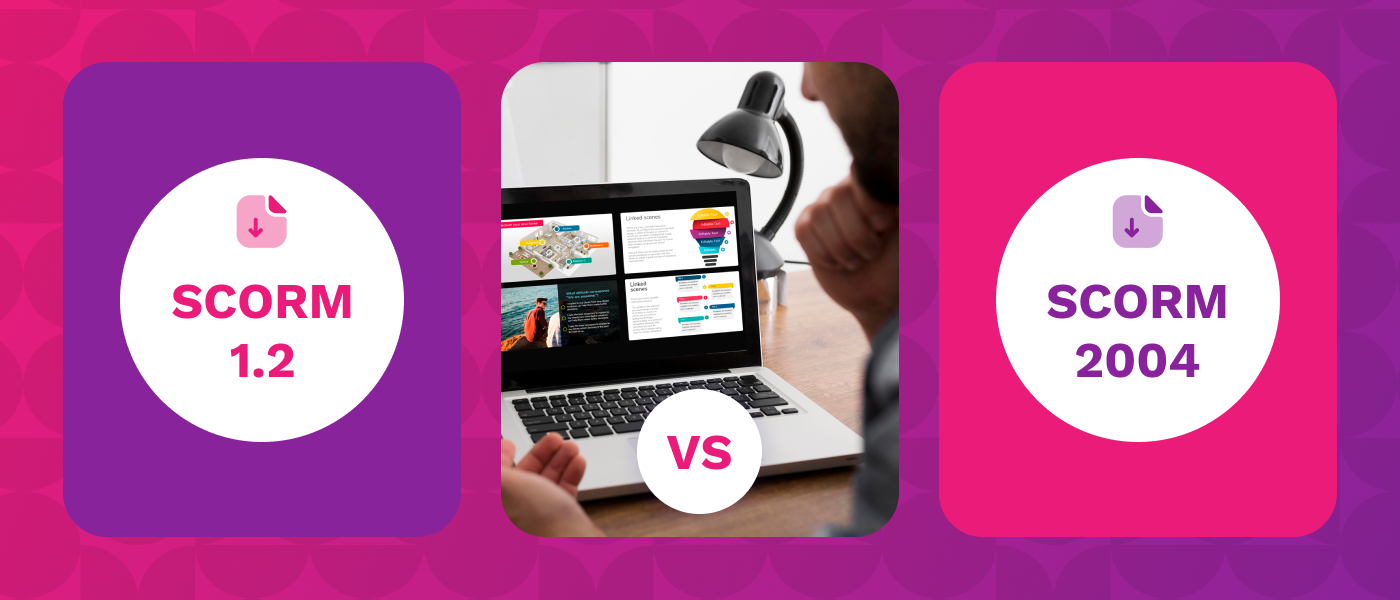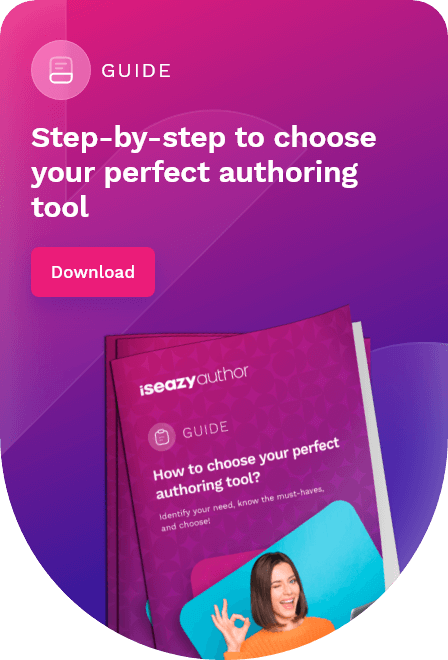Table of contents
ToggleDespite the ongoing evolution that has brought so many changes to e-learning over recent years, the SCORM 1.2 and SCORM 2004 learning standards – 23 and 18 years old respectively – remain as current and important as ever.
In fact, so important are they that they continue to act as the model for many instructional designers and companies, who use them to ensure the full compatibility of training courses with their learning management system (LMS). But what makes them so good?
In this post, we’ll cover the main characteristics of both standards, and explain which you should choose according to your needs.
Introduction to SCORM 1.2 and SCORM 2004
The SCORM, or Shareable Courseware Object Reference Model, was originally an initiative of the US government’s Advanced Distributed Learning (ADL), which sought to standardize the various elements of an e-learning course.
Although its unveiling didn’t cause much of a stir, and many other learning standards already existed, SCORM 1.0 had one key advantage that ended up making it the market reference standard – namely, it utilized the best ideas of all the other standards, integrating them into a complete solution.
A year after its launch, SCORM 1.1 and SCORM 1.2 would be published, adding several improvements to the original version. And, although that first update did bring a number of important changes, it was the second that caught hold and went on to become truly successful.
SCORM 1.2: more than 20 years at the service of e-learning
SCORM 1.2 continues to be the most popular standard in use today, utilized in more than 70% of e-learning content. The main reason for this is its ability to be easily implemented, both with content creation tools and in LMS.
However, this model does feature some important limitations, especially when it comes to hosting large courses. Fortunately, SCORM 2004 came to solve this exact problem.
SCORM 2004: an evolution in attractive course design
In 2004, the ADL decided to publish a new version of SCORM, appropriately called SCORM 2004, which brought a host of new improvements.
With this new version, a single content package could contain multiple elements, allowing content authors to include entire courses in a single SCORM package. As might be expected, this new version was born with a number of comprehensive bugs that forced new updates.
Over the following 5 years, the ADL released up to three more updates to SCORM 2004, although significantly, it has never quite attained the same level of popularity as version 1.2. So, what makes them different?
Key differences between SCORM 1.2 and SCORM 2004: What distinguishes them?
The most important differences between version 1.2 and 2004 are as follows:
| Feature | SCORM 1.2 | SCORM 2004 |
| Data suspension limit (characters) | 4,096 | 64,000 (as of the 3rd edition) |
| Detailed description of interactives | No | Yes |
| Separate completion states | No | Yes |
| Can be used without a web browser | No | No |
| Can be hosted without an LMS | No | No |
| Can contain multiple SCOs | No | Yes |
| SCOs can be sequenced to show partial scores | No | Yes |
| Sequential specification complicates implementation | No | Yes |
| Compatibility with LMS and authoring tools | Over 90% | Under 50% |
| Installation | Easy. Does not require a high level of expertise in development. | More complex, an ad hoc development team may be required. |
| Maintenance | Straightforward – its simplicity allows for the quick resolution of problems. | Tends to cause specific software issues, |
| Platform compatibility | Works with the vast majority of LMS and authoring tools. | Not compatible with all LMS or authoring tools. |
| Capacity and memory | Limited in extensive courses. Can cause problems for students. | Much better capacity for long courses. |
| Feedback | Only offers students a ‘final score’. | Allows feedback to be given in a much more consistent way. |
As the comparison reveals, SCORM 2004 does have significant advantages over SCORM 1.2, since it allows you to create more complete and attractive courses. On the other hand, however, version 1.2 is compatible with most LMS.
Advantages and limitations of SCORM 1.2
The limitations of SCORM 1.2 are greater in number than the advantages it offers, but it has one key benefit that weighs heavily when it comes to choosing between this and the 2004 version – compatibility with LMSs.
Advantages
- Extensive compatibility with LMSs and authoring tools.
- Simple and reliable. It is a simple tool to use and implement, with minimal problems interacting with other software.
Disadvantages
- Since you are limited to using web content, monitoring learning activities presents a difficulty.
- Has problems with extensive courses. Its limit of 4,096 characters means that students are required to complete all of their training in one run.
- Courses can only have one state at a time, for example approved, completed etc.
Advantages and limitations of SCORM 2004
The advantages of SCORM 2004 are greater in number than those of its predecessor, but do they make it more worthwhile?
Advantages
- More capacity. It allows you to integrate more elements (images, activities, etc.) into the courses.
- Better performance.
- It can have several statuses at the same time: for example, completed/approved, or completed/failed.
- Allows you to review students’ responses.
- A significant increase in the number of characters. With the arrival of the 3rd edition the limit leapt from 4,000 to 60,000 characters.
Disadvantages
- It can only be used with web content.
- It is more difficult to use than SCORM 1.2.
- SCORM 2004 compatibility with LMSs is much lower than SCORM 1.2.
Practical implementation: when to use SCORM 1.2 vs. SCORM 2004
Now, when it comes to making a final decision, it’s important to attend to the specific needs of your training course. What should you take into account?
When to choose SCORM 1.2
- In training programs that do not include an extensive set of modules/topics.
- When the LMS or authoring tools being used are not compatible with SCORM 2004.
- When you only need to use web content.
When to choose SCORM 2004
- In e-learning courses with multiple modules and elements (videos, exercises, interactive, etc).
- When the LMS and authoring tools being used are compatible with SCORM 2004.
- When you have access to a development team that can solve software incompatibility problems.
The future of SCORM and emerging alternatives
So, are these two SCORM packages the only choices for developing e-learning courses? No – in fact, there are other alternatives, such as xAPI, that are complementary to SCORM.
The revolution in content consumption is taking the learning experience far beyond traditional SCORM packages in ordinary LMSs, and this is where xAPI comes into play. The Experience API allows you to record any learning experience, wherever you are and however you like. In addition, alternatives like xAPI respond directly to the main limitations of SCORM. For example:
- It provides detailed test results.
- It doesn’t require an LMS.
- You don’t need an internet browser to use it.
- It offers you complete control over all content.
- It can be used in mobile applications.
Despite this, the future of SCORM does not seem to be completely compromised in the medium term. In fact, nowadays, e-learning courses allow the use of many different types of resources, amongst which SCORM remains key.
isEazy Author: Create and share SCORM courses in minutes
Whether you are an instructional designer or in charge of training for your company, you need a tool that allows you to do two important things: create courses quickly and intuitively, and export them in SCORM format to feature them in your learning platform.
With isEazy Author you can easily export all your courses (both in SCORM 1.2 and SCORM 2004 as well as in Tin Can/xAPI) and upload them to any LMS of your choice. Simply download your package, then upload it to your preferred platform.
But it doesn’t stop there, as isEazy Author also offers other distribution options. If you don’t need to track or evaluate a student’s course, you can share the training through a link or even upload it to your company’s Intranet. What’s more, you can also share the course from the same software, as well as keep an eye on tracking, manage teams and even offer certificates. So what are you waiting for? Try it today!















